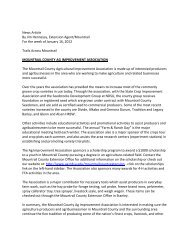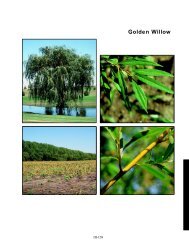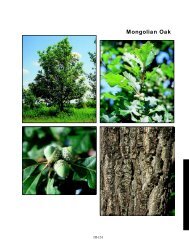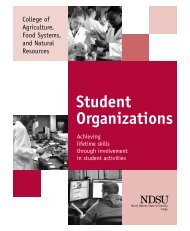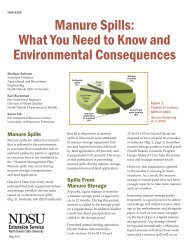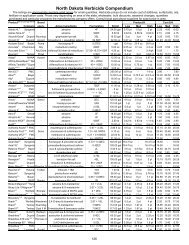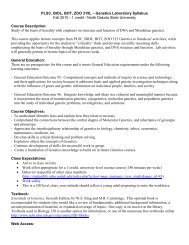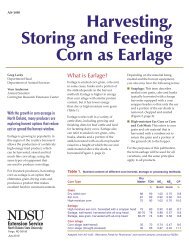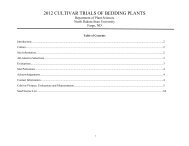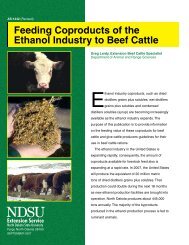NDSU Beef Feedlot - NDSU Agriculture - North Dakota State ...
NDSU Beef Feedlot - NDSU Agriculture - North Dakota State ...
NDSU Beef Feedlot - NDSU Agriculture - North Dakota State ...
Create successful ePaper yourself
Turn your PDF publications into a flip-book with our unique Google optimized e-Paper software.
Table 3. Carcass traits of cattle fed mixed coproduct protein supplement at increasing levels.<br />
Percent Co-Product supplement Contrasts<br />
Item 0% 5% 10% 15% Std. Error P-Value CPS vs. no CPS linear quadratic<br />
Hot Carcass Wt., lbs. 789.2 820.8 794.2 806.5 25.09 0.31 0.23 0.65 0.46<br />
Dressing Percent 63.25 64.18 63.26 63.95 0.38 0.39 0.11 0.32 0.26<br />
Back Fat, in 0.40 0.46 0.37 0.42 0.03 0.02 0.78 0.47 0.59<br />
Ribeye Area, sq in 13.50 13.62 13.62 13.71 0.27 0.85 0.47 0.43 0.93<br />
Kidney Pelvic Heart, % 2.43 2.43 2.44 2.42 0.02 0.94 0.94 0.75 0.66<br />
USDA Yield Grade* 2.66 2.90 2.51 2.71 0.10 0.07 0.67 0.50 0.84<br />
Marbling Score** 421.8 434.9 445.7 438.9 16.04 0.79 0.36 0.41 0.56<br />
Percent Choice*** 61.36 67.44 76.74 77.27 - - - - -<br />
* USDA Yield Grade is a calculated value that is determined by a formula comparing fat to lean muscle in the carcass.<br />
** Marbling score is based on intermuscular fat in the ribeye: 400-499 = low Choice , 500-599 = Avg Choice.<br />
*** Percent choice was not statisitically analyzed.<br />
Implications<br />
The results of this study suggest that a mixed co-product ―superfeed‖ may be successfully marketed<br />
based on animal performance and especially based on percentage of USDA Choice carcasses. The<br />
ease of use, safety, and handling properties of this pelleted commodity are superior to any single feed<br />
ingredient. Using soybean meal as a base ingredient helps increase the value of the meal and diversify<br />
the market potential to other species or production scenarios. This study gives confidence to livestock<br />
producers interested in using a combinatorial feed comprised of multiple co-products. It remains to be<br />
seen if feed manufacturing businesses are interested in developing commodities from combining coproducts<br />
into commercial pelleted feeds to produce products that can be labeled as <strong>North</strong> <strong>Dakota</strong><br />
―Superfeed.‖<br />
Effects of Dried Distillers Grains With Solubles on Growing and Finishing<br />
Steer Intake, Performance, Carcass Characteristics, Color and Sensory<br />
Attributes<br />
J.L. Leupp 1 , G.P. Lardy 1 , M.L. Bauer 1 , K.K. Karges 2 , M.L. Gibson 2 , J.S. Caton 1 and R.J. Maddock 1<br />
1 <strong>NDSU</strong> Department of Animal Sciences<br />
2 <strong>Dakota</strong> Gold Research Association, Sioux Falls, SD<br />
The objectives of this study were to determine the effects of dried distillers grains with solubles on<br />
growing and finishing performance, carcass characteristics and meat quality traits. These data suggest<br />
dried distillers grains with solubles (DDGS) can be included at 30 percent dietary dry matter (DM) in<br />
both the growing and finishing period, partially replacing dry-rolled corn, with no detrimental effects on<br />
performance, carcass characteristics or sensory attributes, although DDGS may affect color negatively.<br />
Summary<br />
Seventy-two crossbred and purebred beef steers (653 ± 20 pounds initial body weight [BW]) were used<br />
in a completely randomized design to determine effects of dried distillers grains with solubles (29.2%<br />
crude protein [CP], 9.7% fat, DM basis; DDGS) on growing and finishing steer intake, performance,<br />
carcass and meat quality traits. The study contained two feeding periods, growing and finishing, which<br />
resulted in four treatments: 0:0, 30:0, 0:30 and 30:30 (diet DDGS percentage fed during growing and<br />
Page 18 2009 <strong>NDSU</strong> <strong>Beef</strong> <strong>Feedlot</strong> Research Report




